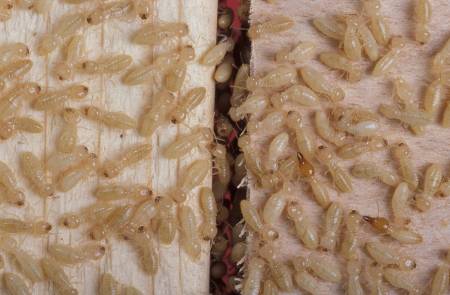


Termites were traditionally classified under the Latin name Isoptera, meaning “equal wings”—a nod to the symmetrical shape and size of their wing pairs. However, modern genetic studies have led to their reclassification under the order Blattodea, grouping them alongside cockroaches due to shared evolutionary traits.
Scientific Classification:
Despite the reclassification, termites are still defined by their highly organised colonies and wood-destructive behaviour. These traits make them a serious structural threat—one that requires professional pest control for effective detection and treatment.
There are over 2,000 different species of termites in the world. Unlike bed bugs, termites can cause serious structural damage to homes and wooden structures. In Singapore, property damage is mainly caused by termite species from the Coptotermes genus.
Termites typically measure between 1/4 and 1/2 of an inch long and have soft bodies with straight antennae. The queens and kings are larger, capable of reaching over one inch long.
Colors range from white to light brown where worker termites often appear lighter while swarming termites are darker.
There are over 2,000 different species of termites in the world, but the termite species that cause property damage in Singapore are primarily of the Coptotermes.
Termites typically measure between 1/4 and 1/2 of an inch long and have soft bodies with straight antennae. The queens and kings are larger, capable of reaching over one inch long.
Colors range from white to light brown where worker termites often appear lighter while swarming termites are darker.
Based on the layout of your home and the degree of termite infestation, Greencare will create a customized treatment plan tailored for your home. This will typically on your specific circumstances and termite species.
Greencare also offers commercial pest control services for business premises affected by termites. We utilise a variety of treatments such as Termidor liquid, dry foam, and Sentricon bait.
Greencare offers one of the best termite pest control solutions in Singapore.
Termites fill one of three roles: workers, soldiers or reproductives. Workers are responsible for gathering food for the colony, maintaining the nest, and caring for the young. Soldiers protect the termite colony by using their large mandibles to fend off predators. Reproductives are the only sexually mature members of the colony, apart from queens and kings.
Termites often invade homes from yards, via cracks or gaps around pipes and wires. Homeowners can also get termites from:
A termite infestation and damage can be devastating to your home or property. Termites are often called the “silent destroyer” because they may be secretly hiding and thriving in your home or yard without any immediate signs of damage. All termites consume cellulose-based plant materials.
Some indications you may have a termite infestation:
Workers and soldiers live approximately one to two years. Queen termites may survive for over a decade under optimal climate conditions.
Workers are responsible for gathering and feeding the colony members, maintaining the nest, and caring for young. Soldiers protect the termite colony using their large mandibles to fend off predators. Reproductives are the only sexually mature members of the colony, aside from queens and kings.
Mating Flight
The life cycle of the termite begins with a mating flight, wherein swarming winged reproductive males and females leave established colonies and procreate. After fertilization, winged termites land and shed their wings, going on to form new colonies. These insects then become the king or queen termites of their newly established colonies. The queen and king termites are at the center of the termite life cycle and are responsible for reproduction.
Eggs
After the fertilized queen lays her eggs, they hatch into pale white larvae.
Molting
Eggs hatch into larvae and molt (shed their exoskeletons) to develop into workers, soldiers, primary reproductives and secondary reproductives. A nymph is a young termite that is going through molts to become a reproductive.
The termite growth process begins with a process called molting. First, a termite develops a soft exoskeleton under its current, hard exoskeleton. Then, once the termite has reached maturity, its outermost skeleton splits open, and the new exoskeleton enlarges and hardens. This molting process continues throughout a termite’s life cycle based on the colony’s needs.
Larvae
Over the course of several molts, these larvae grow to assume a role in one of the three termite colony castes: workers, soldiers and reproductive termites, also known as alates.
Since termites are a constant threat to your home, here are some things you can do during the year to help maintain the effectiveness of Greencare’s termite treatment plan. Small steps make a big difference in termite prevention and sustaining an effective termite treatment plan. Start by eliminating moisture conditions and termite food around your home. These simple steps make your home a less attractive target, helping deter termites.
Eliminate Moisture Problems
Remove Termite Food Sources
If you cannot find the answer to your question in our FAQs, you can always Contact Us . We will answer you shortly!